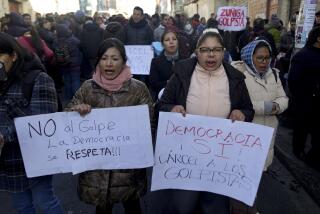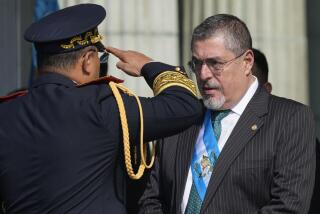PERSPECTIVE ON GUATEMALA : The Coup Was Military, After All : The civil sector isn’t buying the pretense of restoring democracy. Anger is rising, and the crisis can only get worse.
- Share via
What has happened in Guatemala over the past 10 days is not simply a coup d’etat; it is a coup d’etat happening in stages, and it may not be over. President Jorge Serrano Elias has been forced out of office--and has left the country--and Vice President Gustavo Espina Salguero has claimed the office for himself. The process of succession is now being debated, with some in Congress demanding to name an interim president.
The coup was set in motion when, on May 25, Serrano suspended the Constitutional Court, the Congress, the human-rights ombudsman, freedom of the press, freedom of assembly and several other civil rights. These actions were an attempt by Serrano to save himself from being put on trial on corruption charges. They were also an attempt to crush what had become an uncontrollable movement among civilians, aimed at demilitarizing the country and ensuring their participation in the negotiations to end 33 years of civil war.
Mass protests were also mobilizing opposition to a tripling of electricity rates, stemming from austerity measures imposed by the International Monetary Fund. Trade unions were on the verge of declaring a general strike. Protests against measures to impose a special ID and uniforms on junior high school students had reached an unprecedented high. Moreover, the country’s grass-roots “popular” and indigenous Indian movements were readying a wave of activities to demand a seat at the negotiating table on a par with the insurgency, the army and the government. This surge in civilian organizing was the main target of both the May 25 coup and the June 1 coup.
Initially, the army supported the coup. When, a week later, the army withdrew its support for Serrano, most of the U.S. news media reported it as an end to the nation’s crisis and a restoration of democracy. In fact, the army’s action was the second part of the coup, as proved by events on Tuesday. Bomb threats were pervasive, with bombs actually going off in two of the capital city’s shopping centers. None of this violence was directed against Serrano, who was under military protection at the time. Radio stations were once again forced to spend the day playing marimba music and announcing the official army version of part two of the coup. Indeed, on both May 25 and June 1, it was the high command of the Guatemalan army that led in the planning and staging of the coup.
The people’s response to the May 25 coup surpassed all expectations. Defying Serrano’s decrees, Archbishop Prospero Penados convened a public, outdoor Mass “in repudiation of the coup” on Sunday. Employees blocked entry to the Supreme Court building as Serrano attempted to swear in his newly chosen judges. Students held a Mass in memory of Abner Abdiel Hernandez, a 17-year-old who died on May 13, two days after being shot by a congressional bodyguard. Journalists defied government censorship, holding a public demonstration and distributing banned newspapers to commuters in downtown Guatemala City. Encouraged by human-rights ombudsman Ramiro de Leon Carpio and Nobel Peace Prize winner Rigoberta Menchu, the civilian sector refused to be intimidated, bought or confused.
As opposition mounted, Serrano became discredited abroad as well as at home. The electoral tribunal refused to go along with his plan to elect an assembly to revamp the constitution. The United States and the European Economic Community cut off aid. Guatemala was also in imminent danger of losing its U.S. trade status, much to the chagrin of the Guatemalan Chamber of Commerce. It was clear that the coup wasn’t working.
The purpose of the June 1 action, led by Defense Minister Jose Domingo Garcia Samayoa, was to keep the military from losing control, to isolate and repress protesters and to avoid opening peace talks to representative civilian groups. Rigoberta Menchu, observing that “the social sectors have been excluded” from the army’s plan for an interim government, said, “We are not going to give approval to a coup with a civilian facade.”
The crisis in Guatemala is not over. Human-rights abusers still run the military, and the military still runs the government. The civil war continues, and the demands of the disenfranchised are yet to be met. Rather than solving the country’s problems, the May 25-June 1 coup is merely a prelude to even greater conflict in Guatemala.
More to Read
Sign up for Essential California
The most important California stories and recommendations in your inbox every morning.
You may occasionally receive promotional content from the Los Angeles Times.













